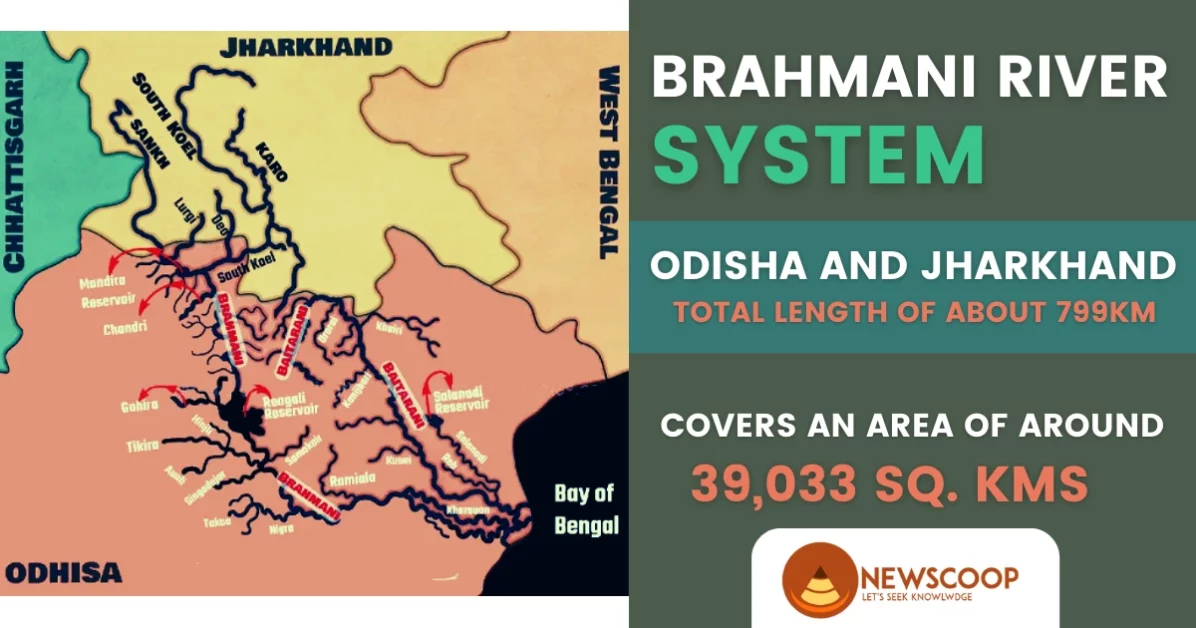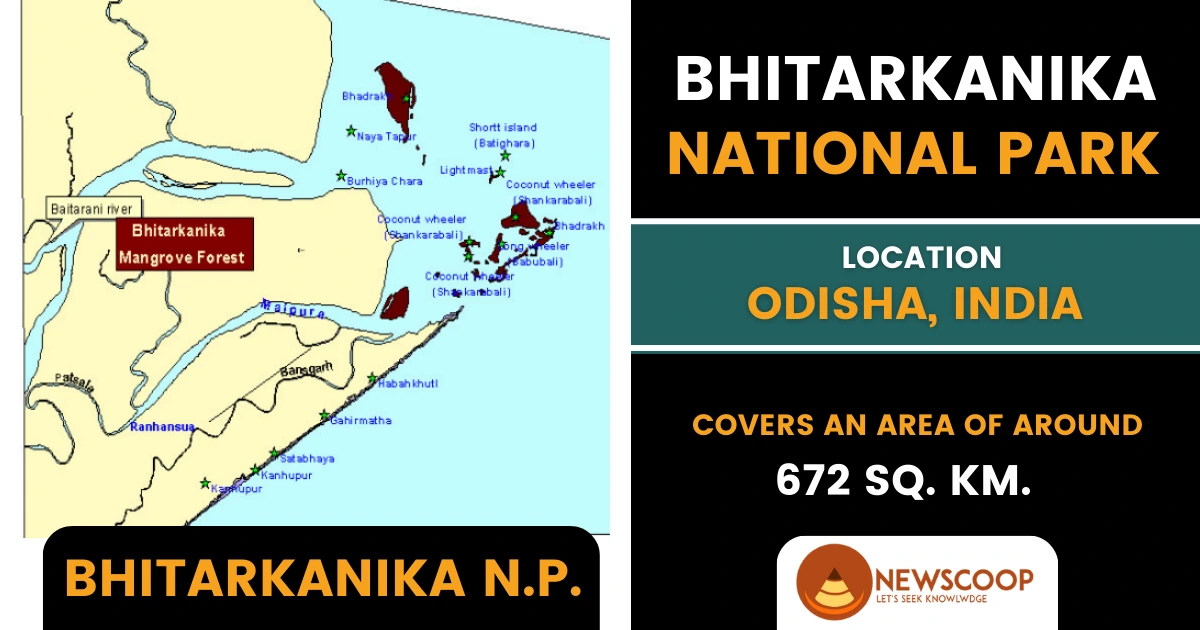In this article, we delve into the fascinating realm of Bhitarkanika National Park—a natural treasure nestled in the heart of Odisha. With its rich biodiversity, unique mangrove forests, and ongoing conservation efforts, Bhitarkanika emerges as a topic of utmost importance for UPSC aspirants.
We explore the park’s geographical features, its diverse flora and fauna, and the significance of its conservation initiatives. Join us as we unravel the wonders of Bhitarkanika National Park, unlocking a world of knowledge for those preparing for the UPSC examinations.
Geographical Features of Bhitarkanika National Park
Bhitarkanika National Park is characterized by its distinctive geographical features, which contribute to its ecological significance and unique ecosystem.
Location of Bhitarkanika National Park
Bhitarkanika National Park is located in the Kendrapara district of Odisha, India, along the Bay of Bengal coastline. Positioned in the northeastern part of the state, the park lies at the delta formed by the Brahmani and Baitarani rivers. Geographically, Bhitarkanika National Park is situated at approximately 20.5878° N latitude and 87.0580° E longitude.
Area of Bhitarkanika National Park
Bhitarkanika National Park covers an approximate area of 672 square kilometers. This expansive region encompasses a diverse range of habitats, including mangrove forests, estuaries, creeks, mudflats, and coastal areas. The vastness of the park provides ample space for various flora and fauna to thrive within its boundaries.
Rivers in Bhitarkanika National Park
Bhitarkanika National Park is located at the delta of two rivers – the Brahmani and Baitarani rivers. These two rivers play a significant role in shaping the landscape and ecology of the park.
1. Brahmani River
The Brahmani River is a major river in the eastern Indian states of Odisha and Jharkhand. Here are some key points about the Brahmani River:
- The Brahmani River originates from the highlands of the Chhota Nagpur Plateau.
- It flows through the states of Jharkhand and Odisha.
- The river enters Odisha near the town of Rourkela.
- It flows in a southeasterly direction, passing through districts like Sundargarh, Angul, and Cuttack.
- The Brahmani River is approximately 480 kilometers long.
- It merges with the Bay of Bengal, forming a deltaic region.
- The river is fed by numerous tributaries, including the Koel, Sankh, and Sone Rivers.
- The river’s basin is known for its rich mineral resources, including iron ore deposits.
- The Brahmani River supports diverse ecosystems, including wetlands and mangrove forests.
Click the image for further information on the Brahmani River:

2. Baitarani River
The Baitarani River is a significant river in the Indian state of Odisha. Here are some key points about the Baitarani River:
- The Baitarani River originates from the foothills of the Similipal Hills in the Keonjhar district.
- It flows in a northeast direction through the districts of Keonjhar and Jajpur.
- The river receives water from various tributaries, including the Salar, Gangadhar, and Mankada Rivers.
- The Baitarani River plays a vital role in supporting agricultural activities in the region, providing water for irrigation.
- It contributes to the formation of fertile agricultural plains along its course.
- It joins the Bay of Bengal near the town of Chandabali in the Jajpur district.
Explore the Brahmani River by clicking the Image:

Historical Background
Bhitarkanika National Park, situated in Odisha’s Kendrapara district, has a captivating history that spans centuries, rooted in the region’s commitment to wildlife and mangrove ecosystem conservation.
Royal Hunting Preserve: During the British colonial era, Bhitarkanika was designated as a hunting reserve for the royal families. It served as a favored hunting ground for tigers, saltwater crocodiles, and other wildlife species. The park’s dense mangrove forests provided an ideal habitat for these magnificent creatures.
Wildlife Sanctuary Declaration: In 1975, recognizing the area’s ecological importance and unique biodiversity, the Odisha government declared Bhitarkanika as a wildlife sanctuary. This designation aimed to safeguard the diverse flora and fauna, including rare and endangered species. It highlighted the need for conservation efforts to protect the natural treasures of Bhitarkanika.
National Park Status: Bhitarkanika Wildlife Sanctuary was elevated to national park status in 1998, officially becoming Bhitarkanika National Park. This upgrade underscored the park’s significance as a natural gem and emphasized the importance of preserving its rich wildlife, mangrove forests, and wetland ecosystems. The national park’s status aimed to enhance protection and conservation efforts within the park.
Ramsar Site: In 2002, Bhitarkanika was recognized as a Ramsar site, acknowledging its international importance as a wetland of significant ecological value. The Ramsar Convention seeks to safeguard and sustainably utilize wetlands worldwide, highlighting Bhitarkanika’s wetland ecosystems and the importance of their conservation.
Flora of Bhitarkanika National Park
1. Mangrove Forests
The dominant feature of Bhitarkanika National Park is its extensive mangrove forests. These lush green forests are a testament to the park’s ecological importance. The mangrove species found here include the majestic Sundari (Heritiera fomes), Gewa (Excoecaria agallocha), and Keora (Sonneratia apetala). These mangroves provide critical habitat and breeding grounds for numerous organisms.
2. Salt-Tolerant Vegetation
part from mangroves, Bhitarkanika also supports a variety of salt-tolerant vegetation. Casuarina (Casuarina equisetifolia), pandanus (Pandanus odorifer), and various grasses thrive in the brackish water and saline soil conditions of the park.
Fauna of Bhitarkanika National Park
1. Saltwater Crocodile
Bhitarkanika National Park is famous for its significant population of saltwater crocodiles (Crocodylus porosus). It is one of the largest habitats for these majestic reptiles in India. The conservation efforts undertaken here have played a vital role in protecting and conserving this endangered species.
2. Indian Python
The park is also home to the Indian python (Python molurus), a large constrictor snake. These non-venomous snakes are known for their impressive size and can be found resting in trees or near water bodies within the park.
3. Endangered Species
Bhitarkanika National Park provides sanctuary to several endangered species. The Indian spotted chevrotain (Moschiola Indica), a small deer-like animal, finds refuge in the park. The fishing cat (Prionailurus Viverrinus), an elusive feline species, can also be spotted here. Additionally, the critically endangered white-backed vulture (Gyps Bengalensis) is found in the park, emphasizing the park’s importance in conservation efforts.
4. Birds
Bhitarkanika is a paradise for bird lovers, with over 320 avian species recorded in the park. During the winter season, the park becomes a haven for migratory birds. Asian openbill storks (Anastomus oscitans), black-crowned night herons (Nycticorax nycticorax), and various species of kingfishers (Alcedinidae) can be spotted in the park’s wetlands and water bodies.
5. Other Wildlife
Bhitarkanika National Park is home to a diverse range of wildlife. Spotted deer (Axis axis), wild boars (Sus scrofa), monitor lizards (Varanus spp.), and otters (Lutrinae) are some of the prominent mammalian species found in the park. Additionally, the park is home to various snake species, including the king cobra (Ophiophagus hannah) and several non-venomous snakes.
Conservation Efforts & Importance
Bhitarkanika National Park is not only a biodiversity hotspot but also plays a vital role in conserving and protecting various endangered species. The park has been designated as a Ramsar site, indicating its international significance as a wetland ecosystem. It is also a designated wildlife sanctuary and a part of the Bhitarkanika Wildlife Sanctuary, which further strengthens its conservation status.
The park’s management actively engages in various conservation initiatives, including habitat restoration, ecological research, and community involvement. Several programs have been implemented to safeguard the fragile ecosystem, such as eco-tourism, awareness campaigns, and sustainable livelihood options for the local communities. These efforts have not only contributed to the protection of the park’s biodiversity but have also helped in the economic development of the region.
Conclusion
In conclusion, Bhitarkanika National Park stands as a true testament to the magnificence and significance of biodiversity. With its sprawling mangrove forests, diverse flora, and captivating fauna, the park offers a remarkable sanctuary for numerous species.
From the majestic saltwater crocodile to the elusive Indian python, and from the endangered Indian spotted chevrotain to the vibrant Asian openbill storks, Bhitarkanika presents a captivating tapestry of life. This natural haven not only provides a habitat for numerous species but also plays a vital role in conservation efforts. Bhitarkanika National Park serves as a reminder of the importance of preserving and protecting our natural treasures for generations to come.
Thank You!
Where is Bhitarkanika National Park located?
Bhitarkanika National Park is located in the state of Odisha, India. It is situated in the Kendrapara district of Odisha, along the northeastern coast of the country.
When was Bhitarkanika National Park declared as a Ramsar site?
Bhitarkanika National Park was declared as a Ramsar site in the year 2002.





